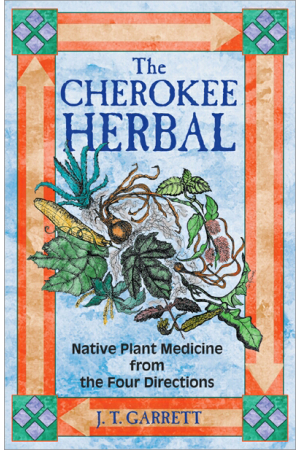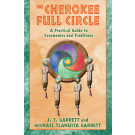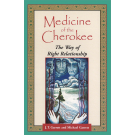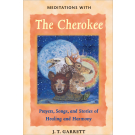- Pages: 288
- Book Size: 5.38 x 8.25
- ISBN-13: 9781879181960
- Imprint: Bear & Company
- On Sale Date: February 27, 2003
- Format: Paperback Book
- Illustrations: 7 b&w illustrations
A practical guide to the medicinal uses of over 450 plants and herbs as applied in the traditional practices of the Cherokee.
• Details the uses of over 450 plants for the treatment of over 120 ailments.
• Written by the coauthor of Medicine of the Cherokee (40,000 copies sold).
• Explains the healing elements of the Four Directions and the plants associated with them.
• Includes traditional teaching tales as told to the author by Cherokee Elders.
In this rare collection of the acquired herbal knowledge of Cherokee Elders, author J. T. Garrett presents the healing properties and medicinal applications of over 450 North American plants. Readers will learn how Native American healers utilize the gifts of nature for ceremonial purposes and to treat over 120 ailments, from the common cold to a bruised heart. The book presents the medicine of the Four Directions and the plants with which each direction is associated. From the East comes the knowledge of "heart medicine"--blood-building tonics and plants for vitality and detoxification. The medicine of the South focuses on the innocence of life and the energy of youthfulness. West medicine treats the internal aspects of the physical body to encourage strength and endurance, while North medicine offers a sense of freedom and connection to the stars and the greater Universal Circle. This resource also includes traditional teaching tales to offer insights from Cherokee cosmology into the origin of illness, how the animals found their medicine, and the naming of the plants.
Chapter 4. EAST MEDICINE
EAST Medicine focuses on the viability of life, the heart, and energy within the body and the Universal Circle. The "Old Ones" are those who are the keepers of the universal knowledge, the sacred ways, and the secrets of life here on Mother Earth. Some would say that the old ways are lost, while others did say the knowledge or understanding is within every cell of our body. The East Medicine takes us from the center or sacred fire or beginning into life here on Mother Earth and part of a family. Therefore the East Medicine starts with being born into a family, clan, and tribe.
The color red and sometimes yellow are associated with the East direction, as represented by the power of the Sun. Little is said in stories and myths of the Cherokee about anything before the direction of the East. However, there is always reference to "Oh ghe doh dah" or "Ye ho wah" as the Great One that is a universal energy in the circle of all things. After that, there are "apportioners" that start with the Sun in the direction of the East. Each direction is like a gate with a gatekeeper. The color is a quick visual reminder of the power of the East, which is sometimes the direction of the Thunder Beings with "powerful Medicine to strike the Earth Mother," as an elder said. Therefore, red is a power color used in ceremonies to call for strength.
The Sunflower (Hellianthus annuus) represents humility and power in the bright yellow color that is the "spirit of the Sun that is always in the planting fields of native people everywhere in the world," say the elder teacher. It is a reminder to us that everything on the plant has value for survival and energy. As an example, the oil was used in cooking and the seeds were used to thicken the mush and dough for bean bread. As one teaching elder said, "The sunflower stands in the crossroad between us and the might mountains of Peru, while it is the rainbow connection between native people in the east and the sacred people of the west." Some say it was the first plant to greet the newcomers to the shores of North America, while others said it stood as a sacred sign to let all know they were on sacred ground. The many petals and many seeds represented the fertility of this land and its way of life that will always survive as long as we save four seeds during the winter months to replant in the spring of life and time.
The East Medicine also represents the female and male energy and the gift of birth or "beginning-again." To the Old Ones, birth was a special event for ceremony and a time to give thanks. It was an event that was a beginning-again, or a chance to pass along the ways of our ancestors and to follow the "way of right relationship." This was a new or renewed path or opportunity of life for us as well. Much of the "Medicine" of the East is focused on females, birthing, and the challenges of being female. As a Natchez-Cherokee elder said, "All the native peoples knew of the love Medicine of the Cherokee. It was powerful, and they knew of the formulas gifted by the Great One to resolve the problems of women. Why? Cause they knew the Cherokee people were keepers of Mother Earth, who gave us life in the beginning. We could speak to the plants in another time, so we knew what to do about these things. We know these things today!" The Medicine of the male was usually about ceremony, strength, endurance, and "special Medicine."
Cherokee Medicine in earlier years consisted of formulas such as plants and other natural substances as helpers. The natural substances included water as sacred in healing, ashes from certain woody trees, minerals from shells and certain rocks from the ground, and nature's gifts such as a bee's wing. The focus in this work will be plant-derived substances used in formulas or called "remedies" by the non-Indians who settled in North America. These substances consisted of either four plants or barks or as many as seven for sacred formulas. Few of the plants were used alone, except as an individual root crushed and held on an aching or sore tooth. Mixtures of two Medicines were usually to balance each other, such as a calming agent and a stimulant. Mixtures of three plants were considered a "special Medicine" for "calling on the sky vault spirit ones to drive away bad spirits." Mixtures of four helpers were the usual formula remedy; although five would be ceremonial and six would be for "spirit work." Mixtures of seven substances were usually used for "sacred Medicine and tonics."
The Direction of the East is associated with family, support circle, belonging to a clan and family, and protection of the circle of family and friends. The East Medicine is about the "heart Medicine" with blood building tonics and energy, as well as those plants and substances that were "purifiers to cleanse and clear the body and the blood for Good Medicine." Earlier Indian people understood the heart as an internal organ of special strength. The blood was thought of in a similar fashion as the water that flows through Mother Earth. The heart was considered as having a separate spirit or life in the physical body. While the blood supplied life to the rest of the body, the spirit connection was through a connection that each person had with others in their family, clan, and tribe, as well as with their spirit ancestry to the Great One. This meant that the heart was much more sacred that just a muscle that acted as a physical muscle and pump.
The Cherokee Herbal
Native Plant Medicine from the Four Directions
Chapter One The Medicine Way of Life
Introduction
Chapter Two Being in the Medicine
Medicine Way
Chapter Three The Origin of Cherokee Medicine
The Story of the Rabbit Medicine
Chapter Four East Medicine
Chapter Five The South Medicine
Chapter Six West Medicine
Chapter Seven North Medicine
Appendix Medicine Formulas of Plant and Natural Helpers
East Medicine
References
Making Scents, Winter/Spring 2004, Vol. 8 Issue 2
"Readers will learn how Native American healers utilize the gifts of nature for ceremonial purposes."
AZNetNews, December 2003/ January 2004
"This book is highly recommended. If you are interested in herbal medicine, lore, and the unusual, Garrett's book should be on your reading list. Excellent."
Lee Prosser, Ghostvillage.com, March 2006
"A must for every herbalist's bookshelf, or for anyone who is interested in learning about Cherokee Medicine."
Thora Wodenshild, SageWoman, Summer 2003, No. 62
In this rare collection of the herbal knowledge of Cherokee elders, author J. T. Garrett presents the healing properties and medicinal applications of over 450 North American plants. Readers will learn how Native American healers utilize the gifts of nature for ceremonial purposes and to treat over 120 ailments, from the common cold to a broken heart. The book presents the medicine of the Four Directions and the plants with which each direction is associated. From the East comes the knowledge of “heart Medicine”-- blood-building tonics and plants for vitality and detoxification. The Medicine of the South focuses on the innocence of life and the energy of youthfulness. West Medicine treats the internal aspects of the physical body to encourage strength and endurance, while North Medicine offers a sense of freedom and connection to the stars and the greater Universal Circle. This resource also includes traditional teaching tales to offer insights from Cherokee cosmology into the origin of illness, how the animals found their Medicine, and the naming of the plants.
J. T. GARRETT, a member of the Eastern Band of the Cherokee from North Carolina, is the author of Meditations with the Cherokee and coauthor with his son, Michael, of Medicine of the Cherokee and The Cherokee Full Circle. As a student and teacher of Indian Medicine for over thirty-five years, he draws on the ancient wisdom teachings of his Medicine elders on the Cherokee Reservation in the Great Smoky Mountains. He currently serves as the health director for Carteret County in North Carolina.










